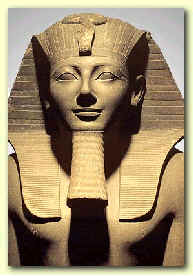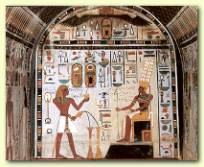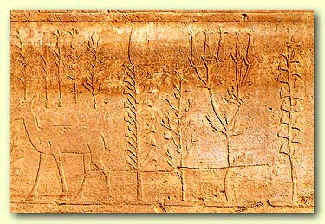|
The Tuthmosis Pharoahs |
|
TUTHMOSIS
was the name that given to four pharaohs in the 18th dynasty. |
| |
Egyptology Articles
Herbs and Aroma
Alternative
Medicine
Aroma Therapy
|
|
The ancient Egyptians had a tradition of repeating the same name of their Pharoahs in different dynasties. Thus a
father, son and grandson would have the same name but with first , second or third after it.
The name TUTHMOSIS was given to four pharaohs in the 18th dynasty. This dynasty was a strong one, a dynasty which also included Queeen
Hatshipsut, one of the most powerful queens on Egypt.
Tuthmosis I was the third king in the 18th Dynasty.His mother was
Semisene.
His birth name we are told was Tuthmosis, meaning "Born of the god Thoth", though this is a Greek version. His actual Egyptian name was Djehutymes I, but he is also sometimes referred to as Thutmose I, or Thutmosis I. His thrown name was A-Kheper-ka-re (Aakheperkara). He gained the thrown at a fairly late age, and may have ruled from 1503-1491BC.Nevertheless, he staged a series of brilliant military campaigns that were to establish Egypt's 18th Dynasty. So effective were these efforts that we believe he must have started preparations of the military operations during the last years of Amenhotep I's rule. Ahmose son of Ebana, an admiral during Tuthmosis I's reign, tells us that a campaign into Nubia where he penetrated beyond the Third Cataract was highly successful. Tuthmosis may have defeated the Nubian chief in hand to hand combat and returned to Thebes with the body of the fallen chief hanging on the prow of his ship.
|
 |
His greatest campaigns were in the Delta and his battles against the Syrians as he finally reached the Euphrates River. This expedition opened new horizons that led later to Egypt's important role in he trade and diplomacy of the Late Bronze Age Near East. Tuthmosis I brought Egypt a sense of stability and his military campaigns healed the wounds of Thebians.
It was by Mutnofret (Mutnefert), a minor queen who was the sister of his principle wife, Ahmose, that his heir, Tuthmosis II was born. Before he had two sons that had died before him.However, his more famous offspring was Queen Hatshepsut, a daughter by Ahmose who would rule after her husband and brother's death. After the death of Ahmose, he probably even took Hatshepsut as his own wife until his death. Ahmose may have also provided him with another daughter by the name of Nefrubity who is depicted with Tuthmosis I and Ahmose in the temple of Hatshepsut at Deir
el-Bahri.
Tuthomosis II
He was the fourth king in the 18th dynasty, the son of Tuthomosis I. In order to strengthen his position and legitimize his rule, he was married to Hatshepsut, the oldest daughter of Tuthmosis I and Queen Ahmose. She was very possibly older then Tuthmosis II. During this period, Hatshepsut also carried the title, "God's Wife of Amun", a position she may have had even before the death of Tuthmosis I.
Hatshepsut would have been both Tuthmosis II's half sister and cousin. In the light of history she became a much better known pharaoh then her husband. Tuthmosis II had only one son. Tuthmosis II must have realized the ambitions of his wife, because he attempted to foster the ascent of his son to the throne by naming his son as his successor before he died. But upon Tuthmosis II's death, his son was still very young, so Hatshepsut took advantage of the situation by at first naming herself as regent, and then taking on the full role of the pharaoh. He may have also had as many as two daughters by Hatshepsut. We are fairly sure one of them was named Neferure and another possible daughter named Neferubity.
Tuthmosis II did not rule much as he was weak and he only ruled for thirteen years after which Queen Hatshipsut made a lot of changes.
Tuthmosis III
It took a while for Tuthmosis III to gain power as his stepmother and aunt was very powerful at that time.However when he did take the reigns he was a very good ruler.
Tuthmosis III became a great pharaoh in his own right, and has been referred to as the Napoleon of ancient Egypt.But perhaps is reputation is due to the fact that his battles were recorded in great detail by the archivist, royal scribe and army commander, Thanuny. The battles were recorded on the inside walls surrounding the granite sanctuary at Karnak. These events were recorded at Karnak because Tuthmosis's army marched under the banner of the god, Amun, and Amun's temples and estates would largely be the beneficiary of the spoils of Tuthmosis' wars.
From inscriptions left on walls of the temples we find that Tuthmosis started to have troubles from Prince Kadesh of Palestine and Syria. He of course due to his vast military training had to deal with all those things.
Thutmose immediately set out with his army and crossing the Sinai desert he marched to the city of Gaza, which had remained loyal to Egypt. The events of the campaign are well documented because they are engraved onto the walls of the temple of Karnak
Tuthmosis III fought with considerable nerve and cunning.He marched to Gaza in ten days and planned the battle to take Megiddo which was held by a rebellious prince named Kadesh. There were three possible approaches to Megiddo, two of which were fairly open, straightforward routes while the third was through a narrow pass that soldiers would only be able to march through in single file.
Though he was advised against this dangerous pass by his commanders, Tuthmosis not only took this dangerous route, but actually led the troops through. Whether by luck, or gifted intuition this gamble paid off, for when he emerged from the tight canyon, he saw that his enemies had arranged their armies to defend the easier routes. In fact, he emerged between the north and south wings of the enemy's armies, and the next day decisively beat them in battle. It apparently took a long siege (seven months) to take the city of Megiddo, but the rewards were great. The sudden and unexpected appearance of Egyptians in their rear forced the allies to make a hasty re-deployment of their troops. There are said to have been over 300 allied kings, each with his own army, an immense force. However, Thutmose was determined and when the allies saw him at the head of his men leading them forward, they lost heart for the fight and fled for the city of Megiddo
The spoils were considerable, and included 894 chariots, including two covered with gold, 200 suites of armor including two of bronze, as well as over 2,000 horses and 25,000 other animals.
Tuthmosis III had marched from Thebes up the Syrian coast fighting decisive battles, capturing three cities, and then returned back to Thebes. Over the next 18 years, his armies would march against Syria every summer and by the end of that period, he established Egyptian dominance over Palestine. At Karnak he records the capture of 350 cities, and in the 42nd year of his rule, Kadesh itself was finally taken.
Thutmose III is compared with Napoleon but unlike Napoleon he never lost a battle. He conducted sixteen campaigns in
Palestine, Syria and Nubia and his treatment of the conquered was always humane. Syria and Palestine were obliged to keep the peace and the region as a whole experience an unprecedented degree of prosperity.
He also made campaigns into Nubia where he built temples at Amada and Semna and restored Senusret III's old canal in his 50th year of rule so that his armies could easily pass on their return to Egypt.
Tuthmosis III built his own temple near Hatshepsut's on a ledge between her temple and that of Mentuhotep. Close by, Tuthmosis built a rock cut sanctuary to the goddess Hathor. This monument was accidentally discovered by a Swiss team when a rock fall exposed its opening. Apparently, the shrine was in use up to the Ramesside period, when it was destroyed by an earthquake.
|
Tuthmosis III's Temple of Hathor |
 |
But of the many monuments associated with Tuthmosis III, none faired better then the temple of Karnak. Wall reliefs near the sanctuary record the many gifts of gold jewelry, furniture, rich oils and other gifts offered to the temple,. mostly from the spoils of war, by Tuthmosis III. He was responsible for the Sixth and Seventh Pylons at Karnak, as well as considerable reconstruction within the central areas of the temple.
| He erected two obelisks at the temple, one of which survives at the Hippodrom at Istanbul. There is also a great, black granite Victory Stele embellishing his military victories.
He also built a new and very unique temple at Karnak that is today referred to as his Festival Hall. The columns are believed to represent the poles of the king's campaign tent. In the rear is a small room with representations of animals and plants bought back from Syria during the 25th year of his reign. For obvious reasons, this room is referred to as the Botanical Garden. |
 |
| Tuthmosis III, we believe ruled Egypt from 1504 BC until his death in 1450 BC. He was buried in the Valley of the kings. The tomb was halfway up a cliff face, and after his burial, masons destroyed the stone stairway leading up to it and concealed the tomb's entrance. However, it would seem that no matter what initiatives pharaohs took to protect their tombs, robbers were sure to find them. Indeed, in 1898 when his tomb was discovered by Victor
Loret, all he found was the carved sarcophagus and some remains of smashed furniture and wooden statues. |
 |
|
From Tuthmosis III's Tomb |
Tuthmosis III, mummy likewise was not in the tomb, for it had been found in 1881 in the great royal cache at Deir el-Bahari. However, the tomb is covered with black and red painted hieratic renditions of the netherworld texts.
The Pharaoh Tuthmosis IV, who ruled during Egypt famous 18th Dynasty, is probably most famous for his "Dream Stele, that can still today be found between the paws of the great Sphinx at Giza. Dreams were important in ancient Egypt and were considered to be divine predictions of the future. In Tuthmosis IV's "Dream Stele", he tells us that, while out on a hunting trip, he fell asleep in the shadow of the Sphinx (or apparently, the shadow of the Sphinx's head, for the monument was apparently buried in sand at the time). In the young prince's sleep, Re-Harakhte, the sun god embodied in the Sphinx, came to him in a dream and promised that if he would clear away the sand that engulfed the monument, Tuthmosis would become king of Egypt.
|
You may freely reprint this article
or place it on your website by
adding this statement: Courtesy of www.kingtutshop.com
|
_________________________________



